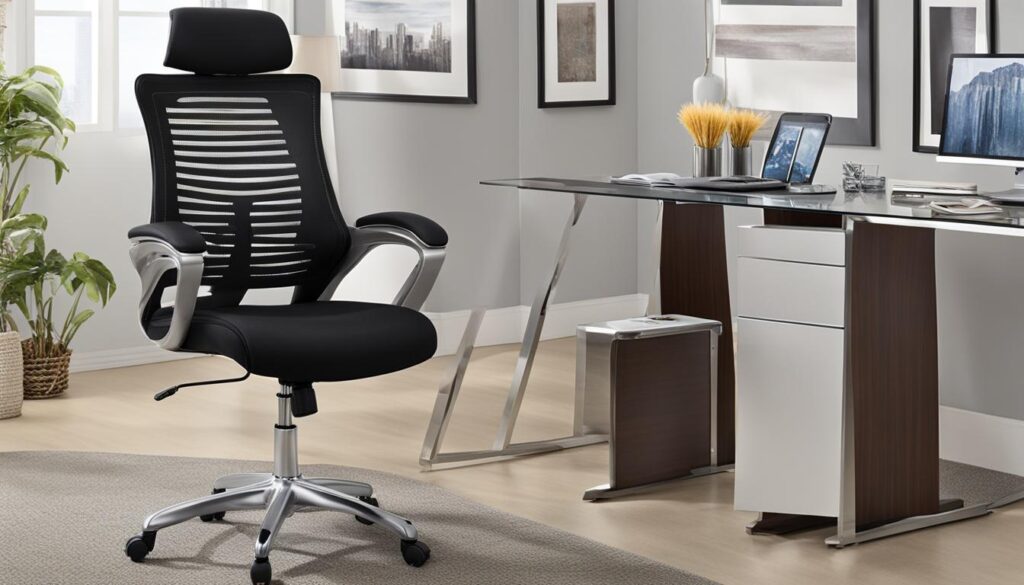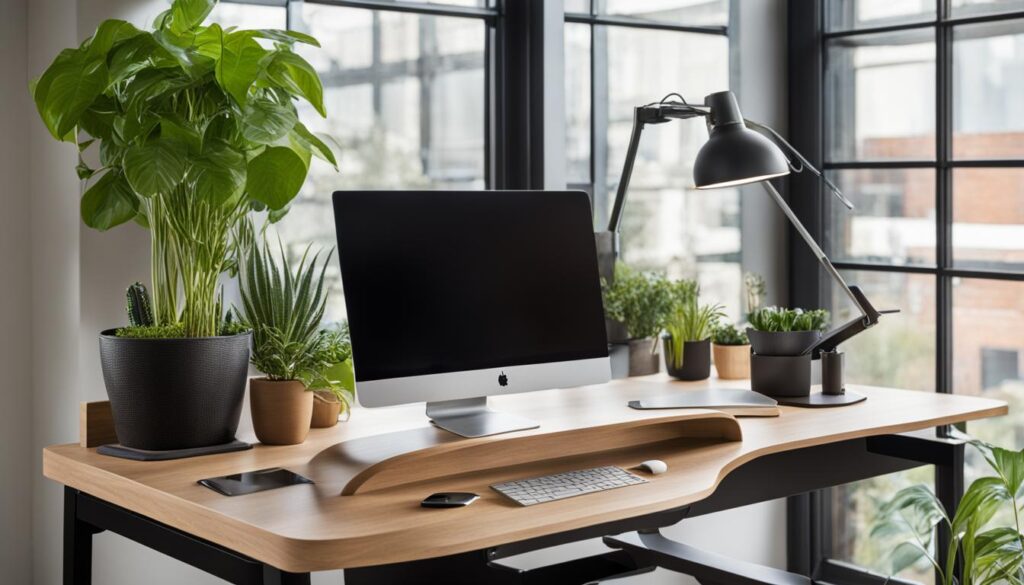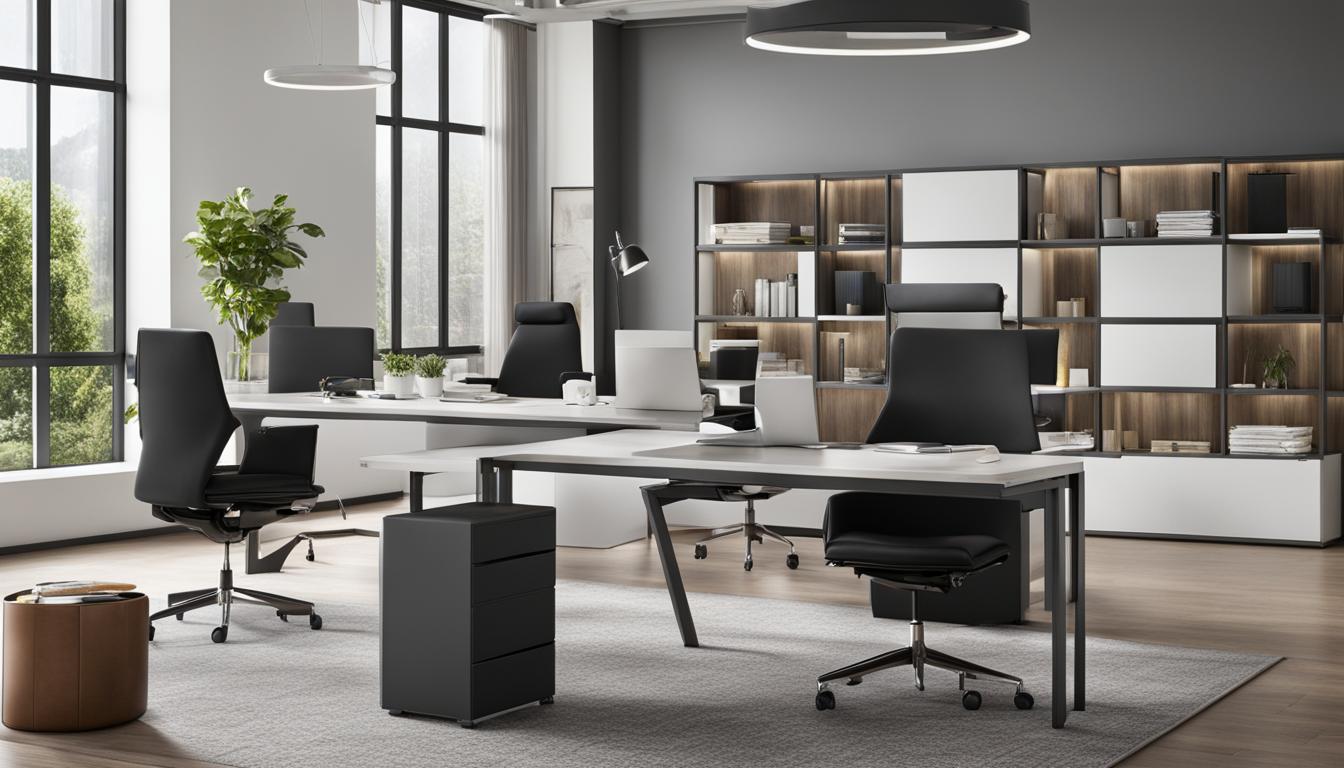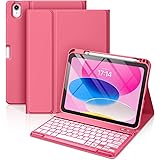Office furniture plays a crucial role in creating a stylish and functional workspace. By choosing the right furniture, you can enhance the aesthetics of your office while ensuring durability and comfort. With a wide range of options available, it’s important to consider factors such as ergonomics, storage solutions, and overall design to create an optimal work environment. Whether you’re looking for home office furniture or modern office furniture for a corporate setting, this guide will provide you with essential information to make informed choices.
Key Takeaways:
- Choose office furniture that combines style, durability, and comfort.
- Consider factors such as ergonomics, storage solutions, and overall design when selecting office furniture.
- Invest in ergonomic office furniture to promote proper posture and reduce the risk of musculoskeletal issues.
- Maximize office storage and organization to enhance productivity and minimize clutter.
- Add decorative elements and modern office furniture to create an inspiring and visually appealing workspace.
Choosing the Right Office Desk for Your Needs
In order to create an efficient workspace, it is essential to choose the right office desk that suits your needs. Consider the size of your office and measure the available space to ensure that the desk fits properly. Take into account any doorways or stairwells that the desk needs to go through during installation. Additionally, consider your own height and measurements to determine the appropriate desk height and depth that will provide maximum comfort while working.
There are various types of office desks available, each with its own benefits. Standing desks are popular for their ability to promote better posture and reduce the risks associated with prolonged sitting. Adjustable height desks provide flexibility, allowing you to switch between sitting and standing positions throughout the day. Traditional desks offer a classic and timeless look for those who prefer a more traditional office setting. It is important to choose a desk that suits your work style and ergonomic needs.
To help you make an informed decision, here is a table comparing the different types of office desks:
| Type of Desk | Benefits |
|---|---|
| Standing Desk | Promotes better posture, reduces the risks of prolonged sitting |
| Adjustable Height Desk | Offers flexibility, allows switching between sitting and standing positions |
| Traditional Desk | Provides a classic and timeless look |
By considering your workspace requirements and personal preferences, you can choose the right office desk that enhances your productivity and comfort.
Ergonomic Considerations for Office Desks
When selecting an office desk, it is important to prioritize ergonomic features that promote a healthy work environment. Here are some key considerations:
- Height adjustability: Look for desks that allow you to easily adjust the height to match your sitting or standing position.
- Ergonomic accessories: Consider incorporating accessories such as ergonomic keyboard trays, monitor arms, and wrist rests to further enhance ergonomics.
- Cable management: Choose desks with built-in cable management systems to keep your workspace organized and free from clutter.
- Storage options: Depending on your needs, look for desks with integrated storage solutions like drawers or shelves to help keep your workspace tidy.
By considering these ergonomic factors when selecting your office desk, you can create a workspace that promotes comfort, productivity, and overall well-being.
Selecting the Perfect Office Chair for Comfort and Support
When it comes to creating a comfortable and productive workspace, choosing the right office chair is essential. Your office chair plays a significant role in promoting good posture, reducing the risk of musculoskeletal issues, and enhancing overall comfort during long hours of work. Here are some factors to consider when selecting the perfect office chair:
1. Ergonomic Features:
Look for office chairs with ergonomic features that provide proper lumbar support, adjustable height and armrests, and breathable materials. These features ensure that your body stays properly aligned and supported while you work, reducing strain on your neck, shoulders, and back.
2. Comfortable Cushioning:
Consider the quality and thickness of the seat cushioning. A well-padded seat cushion with ample support ensures that you can sit comfortably for extended periods without experiencing discomfort or fatigue.
3. Mobility and Adjustability:
Choose an office chair that has smooth casters for easy movement across different surfaces. Additionally, opt for a chair with adjustable features such as tilt tension, seat height, and armrest height. This allows you to customize the chair to your specific needs and preferences.
By selecting an office chair that prioritizes comfort, support, and adjustability, you can create a workspace that enhances productivity and promotes overall well-being. Remember to try out different chairs and consider your unique ergonomic requirements before making a final decision.

Table: A Comparison of Popular Office Chair Models
| Office Chair Model | Ergonomic Features | Cushioning | Mobility |
|---|---|---|---|
| Model A | Adjustable lumbar support Height-adjustable armrests |
High-density foam cushioning | Smooth-rolling casters |
| Model B | Integrated lumbar support Fixed armrests |
Moderate cushioning | Non-rolling casters |
| Model C | Adjustable lumbar support 3D adjustable armrests |
Memory foam cushioning | 360-degree swivel casters |
Note: This table provides a general comparison of popular office chair models. It is important to try out different chairs and consider your specific needs before making a purchase decision.
Maximizing Office Storage and Organization
When it comes to creating a productive workspace, office storage and organization are key factors to consider. Clutter and disorganization can lead to decreased efficiency and increased stress. By implementing effective storage solutions and organizing strategies, you can optimize your office space and improve overall productivity. Here are some essential tips and ideas to help you maximize your office storage and organization:
Create a Functional Storage System
An efficient storage system is essential for keeping your office supplies, files, and equipment neatly organized. Consider investing in shelves, cabinets, and drawers that are specifically designed for office use. These storage units should be sized appropriately for your needs and fit well within your office space. Organize your items based on frequency of use and accessibility, ensuring that frequently used items are easily reachable.
Utilize Office Organizers
In addition to larger storage units, it’s important to utilize smaller office organizers to keep your workspace tidy. Desk trays, file holders, and cable management systems can help keep your desk clutter-free and improve overall efficiency. Labeling systems and color coding can also be helpful in organizing and categorizing documents and supplies. Consider implementing a clean desk policy where employees are encouraged to keep their workspaces organized and free from unnecessary clutter.
Implement a Digital Filing System
In today’s digital age, it’s imperative to have a well-organized digital filing system. Use cloud storage solutions and digital document management software to store and organize electronic files. Categorize files into clearly labeled folders and establish naming conventions to make searching and retrieving documents easier. Regularly backup your digital files to ensure data security and prevent loss.
Regularly Declutter and Purge
To maintain an organized office space, it’s important to regularly declutter and purge unnecessary items. Take the time to go through your office supplies, files, and equipment and identify any items that are no longer needed. Donate or recycle items that are in good condition but no longer useful to you. Regularly reassess your storage needs and make adjustments as necessary to accommodate any changes in your office setup or workflow. By keeping your office space clutter-free and well-organized, you can create a more productive and harmonious work environment.
Office Storage and Organization Table
| Storage Solution | Description |
|---|---|
| Shelves | Vertical storage units that can be mounted on walls or placed on the floor. Ideal for books, binders, and decorative items. |
| Cabinets | Enclosed storage units with doors and adjustable shelves. Suitable for storing office supplies, files, and equipment. |
| Drawers | Individual storage units that can be incorporated into desks or placed separately. Perfect for organizing small items such as pens, notepads, and stationery. |
| Desk Trays | Stackable trays that can be used to sort and organize documents, incoming mail, and other paperwork. |
| File Holders | Vertical or horizontal organizers for storing and categorizing files. Can be placed on desks or mounted on walls. |
| Cable Management Systems | Devices and accessories designed to organize and conceal cables and cords, preventing tangles and reducing visual clutter. |
Enhancing Your Office Aesthetics with Decorative Elements
Creating an inspiring and visually appealing workspace goes beyond just choosing the right office furniture. Incorporating decorative elements can significantly enhance the overall aesthetics of your office. By adding artwork, plants, and personal touches, you can infuse your office with personality and create a space that reflects your company’s values and culture.
Consider hanging artwork on the walls to add color and visual interest. Choose pieces that resonate with your brand or inspire creativity. Plants not only bring a touch of nature indoors but also improve air quality and create a calming atmosphere. Incorporate different types of plants, such as succulents or air-purifying plants, to create a diverse and vibrant office environment. Additionally, personal touches such as photographs or motivational quotes can help create a sense of belonging and motivation among employees.
When it comes to office furniture, selecting pieces with stylish laminate sheets can add texture and color to your workspace. Opt for modern office furniture designs that incorporate sleek lines and innovative materials to create a contemporary and professional look. Consider incorporating decorative elements within your furniture choices, such as desks with built-in planters or shelving units with integrated lighting. By seamlessly blending functionality with aesthetics, you can create a workspace that inspires productivity and boosts employee morale.
Table: Elements to Enhance Your Office Aesthetics
| Decorative Elements | Benefits |
|---|---|
| Artwork | – Adds color and visual interest – Reflects company values – Inspires creativity |
| Plants | – Improves air quality – Creates a calming atmosphere – Adds a touch of nature |
| Personal Touches | – Creates a sense of belonging – Provides motivation and inspiration |
| Stylish Laminate Sheets | – Adds texture and color to furniture – Enhances office design |
| Modern Office Furniture | – Sleek lines and innovative materials – Contemporary and professional look |
| Decorative Furniture Elements | – Integrates functionality with aesthetics – Inspires productivity |
The Benefits of Standing Desks for a Healthier Workday
Standing desks have gained popularity in recent years as more people seek to improve their health and well-being while working. The sedentary nature of office work can lead to a myriad of health issues, including weight gain, back pain, and poor circulation. By incorporating standing desks into your office furniture, you can reap numerous benefits that contribute to a healthier and more productive workday.
One of the most significant advantages of using a standing desk is improved posture. When you stand, your body naturally aligns itself, reducing the strain on your back and neck. This can help alleviate existing back pain and prevent future discomfort. Standing also engages your core muscles, promoting better stability and balance. Additionally, standing desks promote better blood circulation, which can help prevent the development of varicose veins and reduce the risk of cardiovascular diseases.
Using a standing desk can also boost your productivity and energy levels. When you stand, you are more likely to stay alert and focused, allowing you to tackle tasks with increased efficiency. Standing can also prevent the mid-afternoon slump that often occurs after long periods of sitting. By incorporating standing breaks into your workday, you can combat fatigue and maintain higher levels of energy throughout the day.

The Future of Office Furniture
The rise in popularity of standing desks has brought about a significant shift in the design and functionality of office furniture. Many standing desks now come with adjustable height mechanisms, allowing you to switch between sitting and standing positions effortlessly. Some even have built-in reminder systems that prompt you to change positions every hour. These advancements in ergonomic office furniture aim to prioritize worker health and well-being.
In conclusion, standing desks offer a range of benefits that can improve your overall health and productivity. By incorporating them into your office furniture setup, you can combat the negative effects of prolonged sitting, enhance your posture, and increase your energy levels. However, it’s important to note that standing desks are not a replacement for regular movement and exercise. It’s still crucial to incorporate breaks and incorporate physical activity into your workday for optimal well-being.
The Importance of Collaborative Spaces in the Modern Office
In today’s fast-paced work environment, collaboration is key to fostering creativity, innovation, and teamwork. That’s why creating collaborative spaces in the modern office is essential. By providing designated areas that encourage spontaneous discussions and idea sharing, you can enhance productivity and cultivate a positive work culture.
Benefits of Collaborative Workspaces
Collaborative workspaces offer numerous benefits that can transform the way your team works. Here are a few advantages:
- Enhanced Communication: Collaborative spaces facilitate open and effective communication, allowing team members to share ideas, solve problems, and make decisions together.
- Increased Innovation: By encouraging collaboration, you create an environment where new ideas can emerge, leading to innovative solutions and approaches.
- Improved Efficiency: When colleagues can work together seamlessly, tasks can be completed more efficiently, reducing duplication of efforts and improving overall productivity.
- Boosted Morale: Collaborative spaces foster a sense of camaraderie and teamwork, leading to increased employee satisfaction and a positive work culture.
Designing Collaborative Spaces
To make the most of collaborative spaces, it’s important to design them thoughtfully. Here are some key considerations:
- Flexible Layouts: Choose furniture that can easily be rearranged to accommodate different group sizes and activities. Modular furniture and movable partitions can create versatile spaces that can adapt to changing needs.
- Mix of Furniture: Incorporate a variety of seating options, such as lounge chairs, standing tables, and bean bags, to cater to different preferences and work styles. This promotes comfort and encourages collaboration in a relaxed setting.
- Technology Integration: Ensure that collaborative spaces are equipped with the necessary technology, such as video conferencing tools and interactive displays, to facilitate seamless virtual collaboration with remote team members.
- Privacy Considerations: While collaboration is important, it’s also essential to provide privacy options for individuals or small groups who require focused work or confidential discussions. Consider incorporating privacy screens or enclosed meeting pods into the design.
By creating collaborative spaces that are conducive to teamwork and communication, you can unleash the full potential of your team and drive innovation in your organization. Embrace modern office furniture designs that promote collaboration, and watch your workplace transform into a hub of creativity and productivity.
Incorporating Biophilic Design in Your Office Space
Creating a workspace that promotes well-being and productivity is essential for any modern office. One effective way to achieve this is by incorporating biophilic design principles into your office space. Biophilic design acknowledges the innate human connection with nature and integrates natural elements into the built environment. By bringing the outdoors in, you can create a calming and inspiring atmosphere that benefits both employees and the overall work environment.
One way to incorporate biophilic design is through the use of biophilic office furniture. This type of furniture features natural materials such as wood, bamboo, or cork, and often incorporates organic shapes and designs. By choosing biophilic office furniture, you can add a touch of nature to your workspace and enhance the overall aesthetic appeal.
Additionally, consider integrating greenery into your office space. Adding plants not only adds a touch of nature but also improves air quality and reduces stress levels. Choose low-maintenance plants that can thrive in an office environment, such as snake plants or pothos. Place them strategically throughout the office to create a more vibrant and inviting atmosphere.
Lastly, use natural light as much as possible. Maximize natural lighting by positioning workstations near windows and using sheer curtains or blinds to control glare. Natural light not only reduces eye strain but also improves mood and overall well-being. If your office doesn’t have access to natural light, consider using full-spectrum lighting that mimics natural sunlight.
“Nature has a profound impact on our well-being, and incorporating biophilic design elements into the office space can create a more harmonious and productive work environment.”
By incorporating biophilic design principles into your office space, you can create a more harmonious and productive work environment. From choosing biophilic office furniture to adding plants and maximizing natural light, these elements will help create a workspace that nurtures employee well-being and promotes a culture of innovation.
The Benefits of Biophilic Design in the Workplace
Biophilic design has been proven to have numerous benefits in the workplace. It has been shown to reduce stress, boost creativity, and improve overall well-being. Studies have found that employees who work in offices with natural elements such as plants and natural light report higher levels of satisfaction and lower levels of stress compared to those in environments lacking these elements. Additionally, biophilic design has been linked to increased productivity and improved cognitive performance.
| Benefits of Biophilic Design in the Workplace | Research Findings |
|---|---|
| Reduced stress levels | Studies have shown that exposure to nature, even in the form of images or views, can significantly reduce stress levels and promote relaxation. |
| Improved cognitive function | Natural elements in the workspace have been found to enhance cognitive function, including improved attention span, memory, and problem-solving abilities. |
| Enhanced creativity | Integrating natural materials and elements into the office space can stimulate creativity and encourage innovative thinking among employees. |
| Increased productivity | Studies have shown that workplaces incorporating biophilic design principles experience increased productivity levels among employees. |
| Improved employee well-being | By creating a more natural and visually appealing workspace, employee well-being and job satisfaction can be significantly improved. |
As you can see, there are numerous benefits to incorporating biophilic design into your office space. By creating a workspace that connects employees with nature, you can enhance their well-being, promote creativity, and improve overall productivity. So why not bring a little bit of the outdoors inside and transform your office into a natural haven?
It is scientifically proven that incorporating natural elements into the office environment can have a positive impact on employee well-being and productivity. By incorporating biophilic design principles, you can create a workspace that fosters creativity, reduces stress, and promotes a healthy work environment. Whether it’s through the use of biophilic office furniture, the integration of greenery, or maximizing natural light, these elements work together to create a harmonious and inspiring space. So why wait? Embrace biophilic design and transform your office into a sanctuary of nature.
Biophilic design acknowledges the innate human connection with nature and incorporates natural elements into the office environment. Consider incorporating office furniture that features natural materials, greenery, and organic shapes to create a calming and inspiring atmosphere. Planters, living walls, and nature-inspired furniture designs can help reduce stress, improve cognitive function, and boost creativity. By integrating biophilic office furniture, you can create a workspace that nurtures employee well-being and promotes a culture of innovation.
One effective way to incorporate biophilic design is through the use of biophilic office furniture. This type of furniture features natural materials such as wood, bamboo, or cork, and often incorporates organic shapes and designs. By choosing biophilic office furniture, you can add a touch of nature to your workspace and enhance the overall aesthetic appeal.
Another important aspect of biophilic design is the inclusion of greenery in the workplace. Adding plants not only brings a sense of nature indoors but also helps improve air quality and reduce stress levels. Choose low-maintenance plants that thrive in an office environment, such as succulents or peace lilies, and place them strategically throughout the office to create a more vibrant and inviting atmosphere.
Natural light is also a key element of biophilic design. Maximize the use of natural lighting in your office by positioning workstations near windows and using sheer curtains or blinds to control glare. Natural light not only reduces eye strain but also has a positive impact on mood and overall well-being. If natural lighting is limited, consider using full-spectrum lighting that mimics natural sunlight.
The Benefits of Biophilic Design in the Workplace
Encompassing biophilic design principles in the workplace has numerous benefits. Studies have shown that employees in offices with natural elements report higher levels of satisfaction, lower stress levels, and increased productivity. Here are some key benefits of biophilic design in the workplace:
- Reduced stress levels: Exposure to natural elements such as plants and natural light has been proven to reduce stress levels and promote relaxation.
- Improved cognitive function: Biophilic design has been linked to enhanced cognitive function, including improved attention span, memory, and problem-solving abilities.
- Enhanced creativity: Incorporating natural materials and elements into the office space can stimulate creativity and foster innovative thinking among employees.
- Increased productivity: Workplaces that incorporate biophilic design principles experience increased productivity levels among employees.
- Improved employee well-being: By creating a more natural and visually appealing workspace, employee well-being and job satisfaction can be significantly improved.
By embracing biophilic design in your office space, you can create a more harmonious and productive work environment. Consider incorporating biophilic office furniture, adding greenery, and maximizing natural light to create a workspace that nurtures employee well-being and promotes a culture of innovation.
Finally, when creating a stylish, functional, and productive workspace, choosing the right office furniture is essential. By considering factors such as ergonomics, storage solutions, collaborative spaces, and biophilic design, you can transform your office into a space that inspires creativity and enhances productivity.
Investing in modern office furniture that combines aesthetics with functionality will not only create a visually appealing workspace but also contribute to the comfort and well-being of your employees. Prioritize ergonomic office furniture to ensure that your team remains comfortable and productive throughout the workday.
Remember, office furniture plays a significant role in shaping the overall atmosphere of your workplace. By selecting the right pieces, you can create an environment that fosters creativity, promotes collaboration, and cultivates a positive work culture. So, when it comes to outfitting your office, make sure to choose wisely and create a workspace that truly reflects your vision and values.











